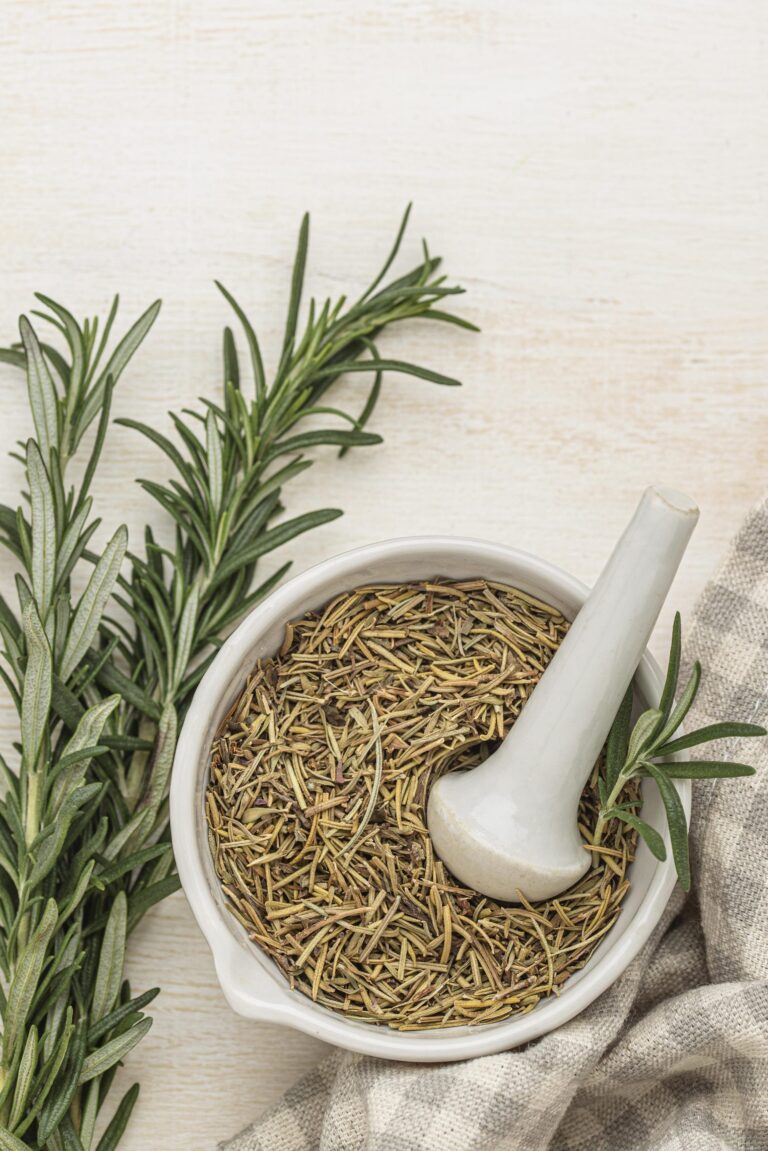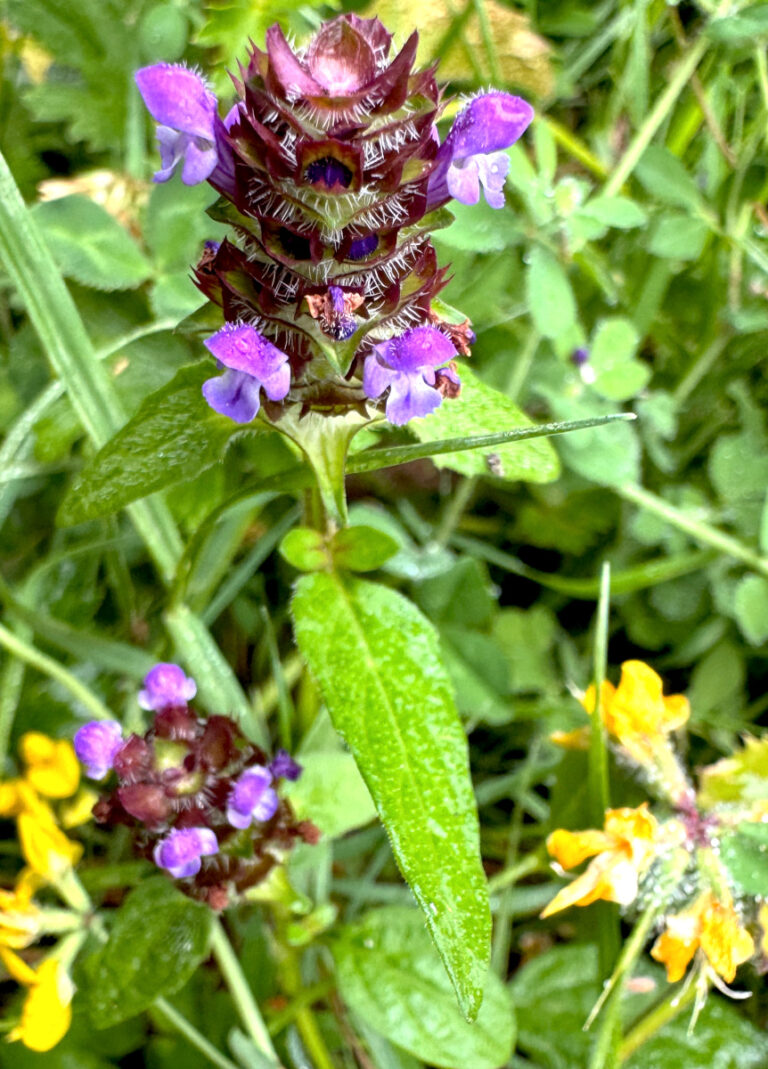Calendula Health Benefits: Natural Healing for Skin and More
Calendula is an herb you need to have in your apothecary. Whether I’m treating a human, pet, or livestock, this is my go-to herb for everything wound and skin related. Discover the health benefits of calendula: from wounds to diabetes and so much more. As a bonus, it’s safe for babies, children, and adults!
*As an Amazon Associate I may earn from qualifying purchases at no cost to you.

How to Identify Calendula
Calendula is typically an annual plant that reaches about 12 inches tall. The leaves are narrow and pointed at the end towards the top of the plant. At the base they tend to be long and rounded.
The flowers are very daisy like, which makes sense because they are both part of the same family of plants. The flowers are often orange in color but can be yellow or even slightly pinkish depending on the variety.
Calendula has been cultivated for a very long time. It is likely to have originated in the S. Europe/Mediterranean region, but is now grown around the world. These days, most people grow it from seeds purchased at various seed stores. The seeds are very distinct, rough to the touch and curved. It’s easy to distinguish them from other seeds!
Growing and Harvesting Calendula
Most people cultivate, or grow, their own calendula. It’s not a highly foraged plant. In general, it’s very easy to grow. Throw seeds in the ground, cover with a bit of dirt, add water and voila! Calendula is an annual plant in most regions around the world. This means you’ll have to replant it every year as it will die off in the fall/winter months.
To harvest for medicinal purposes, wait until the flower is fully in bloom. Use the leaves and flowers for medicinal purposes, not just the flower. Cut off about half the stem with leaves and flowers. Leaving the bottom portion of the plant will encourage it to continue growing and produce more flowers.
If you let calendula go to seed instead of picking the flower, the plant will reseed itself. Be prepared for it to try and take over your flower bed!
Saving seeds is super easy, as well. Let the flower die off and when the petals dry up and fall off, you’re left with the seeds surrounding what’s left of the middle of the flower. Pick them and place them in a paper bag or envelope. You now have seeds for next year, no need to buy them year after year.
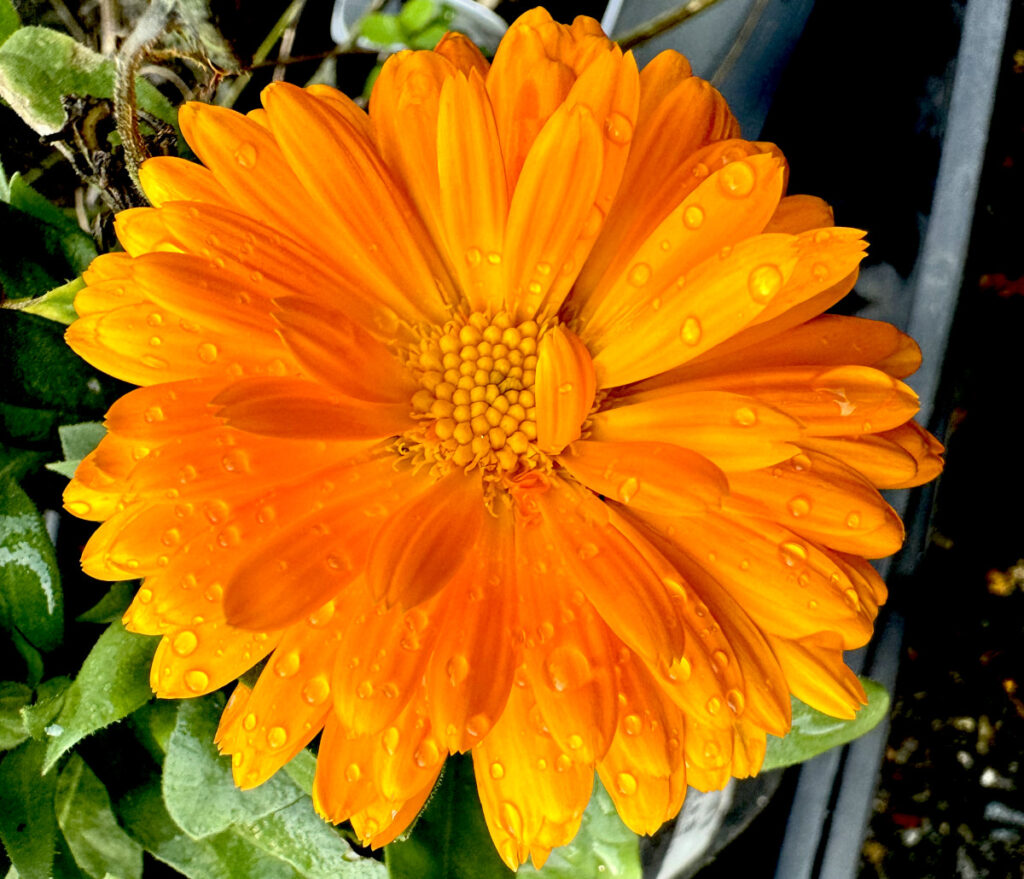
Calendula Health Benefits
*I am not a doctor nor is this medical advice. Please consult with your doctor before starting any medicinal herbs.
I’ve used calendula for years, and have not hesitated to use it for my baby as well. It’s a key ingredient in my diaper rash cream and wound salve. The health benefits of calendula are sure to help your family. But with any herb, consult your doctor before using.
Wound Healing, Antibacterial, and Pain Relief
The small, delicate flower of the calendula plant is a powerhouse when it comes to wounds. This is the most important herb in the wound salve I make. Anything from cuts and abrasions to burns and sunburns to frostbite; calendula can take it on. It is even perfect to tackle snake and insect bites.
The antibacterial properties of calendula help keep wounds clear of infection. The anti-inflammatory properties help calm inflammation and ease pain. Then the plant helps increase collagen production to help those wounds heal.
The next section will go into even more detail on all the things this plant can do to help you heal.
Heal the Skin, From Baby to the Elderly
We all deal with skin issues at some point in our lives. Personally, I deal with minor cuts on my skin, almost on a daily basis around the farm. I’ve also been through chicken pox as a small child and acne as a teenager. Maybe if I’d known that calendula can help with all of these skin conditions I would have been a lot more comfortable!
Scientific studies have also shown that calendula can help heal the rashes from measles and the infected salivary glands of mumps.
It can help with varicose veins, hemorrhoids, infected hair follicles, and boils.
The collagen producing qualities can help repair skin damage. It can also help reduce the appearance of scars and wrinkles.
One of my current favorite uses of calendula is for diaper rash. We do our best, but sometimes my little one gets a touch of diaper rash. I immediately reach for my calendula salve. It clears the rash up quickly and makes baby much more comfortable.
The Power of Antioxidants
Free radicals are molecules that cause a lot of damage to our bodies. They run around causing inflammation, diseases, and even cancer. Antioxidants are what hunts around finding these free radical molecules and kicks them out. Antioxidants are very important to good health.
Calendula is full of antioxidants which benefit so many different internal health issues throughout your body. Studies found that a tincture made with calendula has more powerful antioxidant properties than a tea or decoction. But you can get antioxidant benefits from both. A lot of the hero qualities of calendula I’m about to talk about are because of the power these antioxidants contain.
Alleviate Eye Issues
A cooled tea of calendula is mild enough that you can use it as an eye wash. Got debris or something else stuck in there? Calendula may be able to help.
But it’s also powerful enough that it can take on pink eye. This is something I just recently learned but am definitely storing away for future use. A friend of mine just dealt with pink eye going through her herd of goats. If I had known then what I do now, I would have suggested it to help treat them. It’s not only good for goats, though. It’s also good for when your child brings it home and you inevitably get it as well. The whole family, human and animal, can benefit from the treatment of calendula for pink eye.
I found several references that calendula can help with poor vision. What I didn’t locate, yet, was how. And if it’s any poor vision or only if caused by something specific. If I find those answers, I’ll definitely update this post! For now, take that information as you will.

Good for the Heart
Calendula can help improve blood pressure and circulation. Improving circulation can help with ischemic heart disease.
Studies also showed that the plant can increase pressure and aortic flow from the left ventricle of the heart. This can help decrease the severity of heart attacks and decrease the death of heart muscle cells.
Support the Liver
The liver is the filter of the body. It’s important to take care of it so it can properly filter out all the toxins that invade our system.
Many medicinal plants can help support the liver, calendula is another one to add to your arsenal. It can help decrease the death of liver cells. Cell death can lead to inflammation and liver diseases. The plant can also help protect against acetaminophen induced damage to the liver.
Calendula may also help reduce enzyme changes, making the liver more productive.
Studies have even shown that it can help with jaundice as well. This is also something I wish I knew earlier. Our baby battled jaundice at birth and for the first week of life. If I had known calendula may help, I would not have hesitated to rub some salve over the liver area to help give it a little boost.
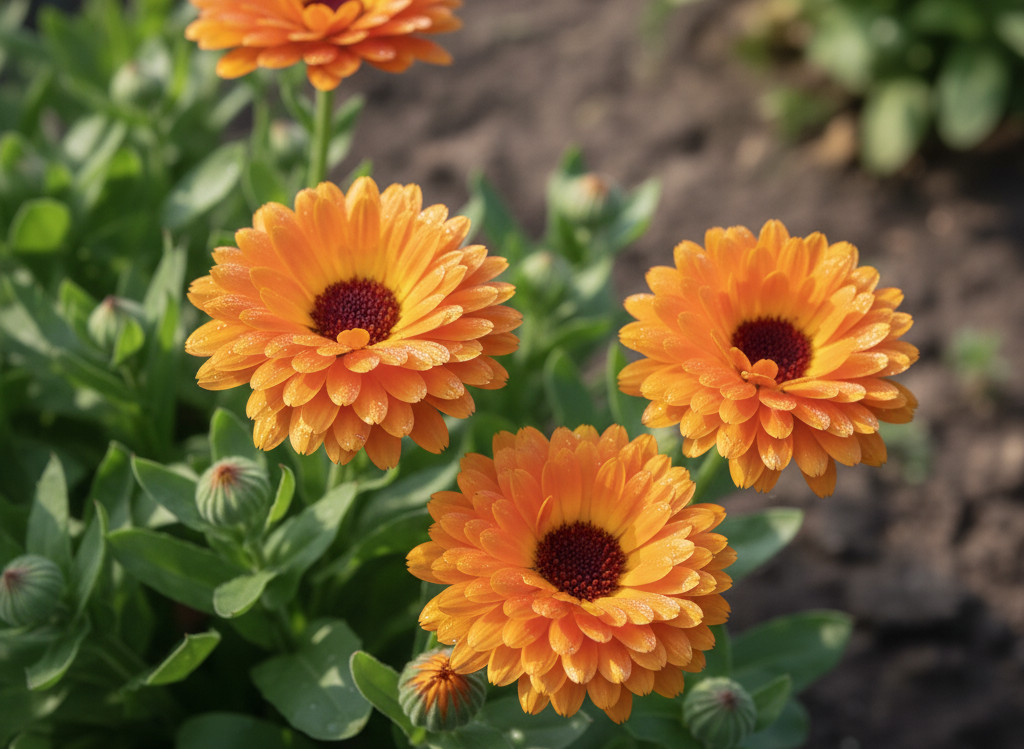
Taking on Diabetes
Diabetes is an epidemic these days. Calendula may be able to provide some support for people dealing with this disease.
Calendula can help reduce blood sugar and urine sugar levels. It works by helping to increase insulin and glutathione production. Glutathione is an antioxidant that helps prevent oxidative damage in the body.
Other Health Benefits of Calendula
Calendula has other benefits that you may find helpful in different ways:
- Antifungal
- Ulcers – may help suppress the formation of ulcers
- Mouth – helps with oral sores, toothache and stomatitis
- Menstruation – may help regulate menstrual cycle and provide relief from cramps
- Antispasmodic – helps with the communication in the parasympathetic nervous system (signals from your brain to involuntary movements of the body)
- Antioedematous – may help reduce fluid retention, may also benefit people with lymphoedema
- Dye – the flowers create a lovely yellow dye
- Compost – can help accelerate composting
How You Can Unlock Calendula’s Health Benefits
There are several ways you can use calendula as medicine and harness the health benefits:
- Make a tea
- Use as a poultice
- Use it as a tincture
- Infuse it in oil
Make a Tea
To make a tea with calendula, take about a tablespoon of dried plant matter and infuse it into about 8 oz of hot water. You can buy reusable tea bags or use tea infusers. I prefer the tea infusers as I find them easier to clean than tea bags.
Once you place the plant matter in the cup, cover the cup with a lid, plate, or something else so the steam does not escape. The steam contains essential oils and medicinal properties, you don’t want to lose them to the air!
Let steep for about 10-15 minutes and enjoy your tea or use it for a poultice!
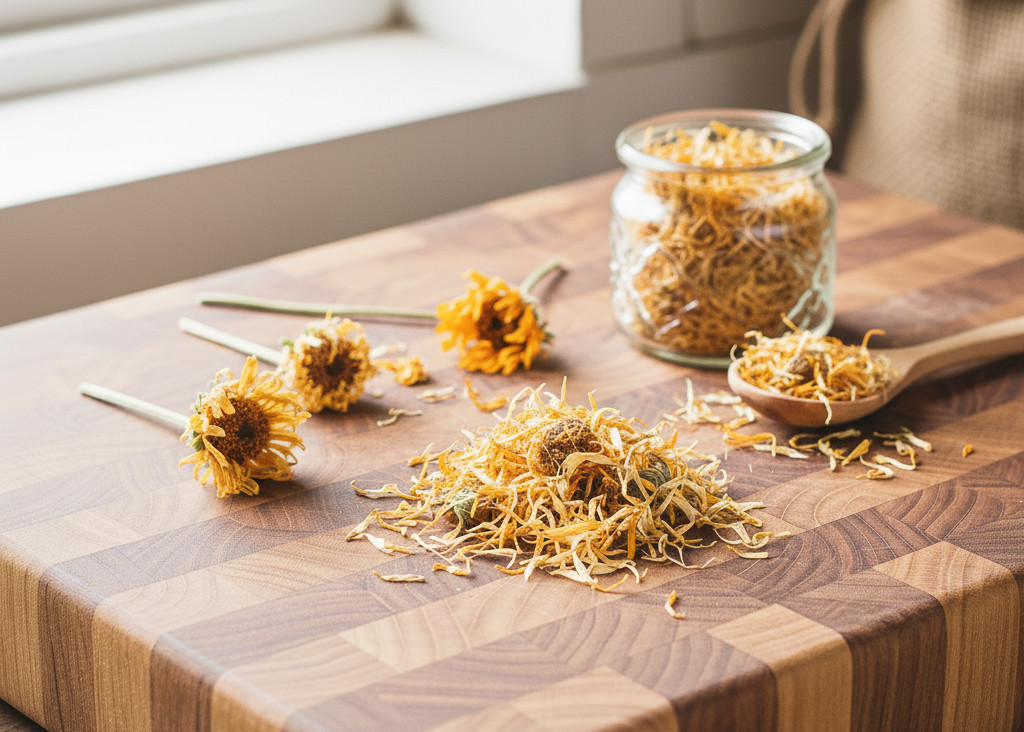
Making a Poultice
You can prepare the plant material several different ways for a poultice. Prepare it as a tea as described above, then soak a piece of material in the tea. A piece of cotton or muslin material works great, but anything that will soak up the liquid will be fine.
You can also make a decoction, which is like a tea. Take 1 oz of dried plant material per quart of boiling water. Pour the boiling water over the plant material, place a lid on, and let it cool completely. This is a great extraction method, you can also drink a decoction just like a tea. Once prepared, use a piece of material to soak up the infused water.
You can also use an oil infusion for a poultice.
For teas, decoctions and oil infusions, place the soaked material straight onto the wound or other place you would like the medicine from the plant to be absorbed.
The fourth option is to use the plant material straight out of the ground. Crush it up to release the juices of the plant. Place the crushed-up plant material directly where you need the medicine. You can hold it there, but I generally tie a piece of material around it to keep the plant in place. Remove after about 20 minutes.
Making a Tincture
Tinctures typically involve alcohol but can be made with vegetable glycerin or vinegar if you do not consume alcohol. Keep in mind that when you are taking a tincture, you are taking such small amounts that it is impossible to feel any effects of alcohol.
I make a tincture by using 100 proof vodka, but you can use 80 proof if that’s all you can find. Fill a jar with fresh calendula. I like to cut it up into smaller pieces so I can fit more in and have more surface area for the alcohol to extract from. I feel it’s important that the plant be fresh, so it still retains all of its water and alcohol soluble properties. Make sure you fill the jar to the top with plant material, don’t pick a jar that’s larger than the amount of plant material you have. It doesn’t matter what jar you use, just make sure it has a lid that is tight.
When your jar is full of calendula, pour the alcohol over it until it reaches the brim of the jar. You may have to let it sit for a minute before the alcohol makes it into all the nooks and crannies. Add more alcohol if necessary. Seal the jar with the lid and sit it in a cool dark place for 6-8 weeks.
When it’s ready, strain out the plant material and your tincture is ready for use. I like using nut milk bags for straining tinctures and oils.
Tinctures are pretty powerful medicine, so start slowly when taking it. Start with just a few drops several times a day, and work up until you reach the number of drops your body needs to feel the health benefits of calendula.
Making an Oil Infusion
An oil infusion is best used to make a salve. My favorite oil to use is avocado oil, but you can use a pure olive oil, grapeseed oil, or basically any oil that isn’t soy or canola based. I wouldn’t recommend using either of those due to their inflammatory properties.
Oil infusions should be made with dry plant material only. Oil and water are the perfect breeding ground for bacteria. if you use fresh plant material your oil is going to end up growing mold.
Fill a jar up with dried calendula, use the stem and all. Just like with a tincture, cut the plant matter into smaller pieces to allow more surface area for extraction.
Pour the oil over the plant material up to the rim of the jar. Cap it tight and place it in a warm, dark place for 6 weeks. After 6 weeks, strain out the plant material and your oil is ready to go! These nut milk bags are my go-to for straining oils and tinctures.
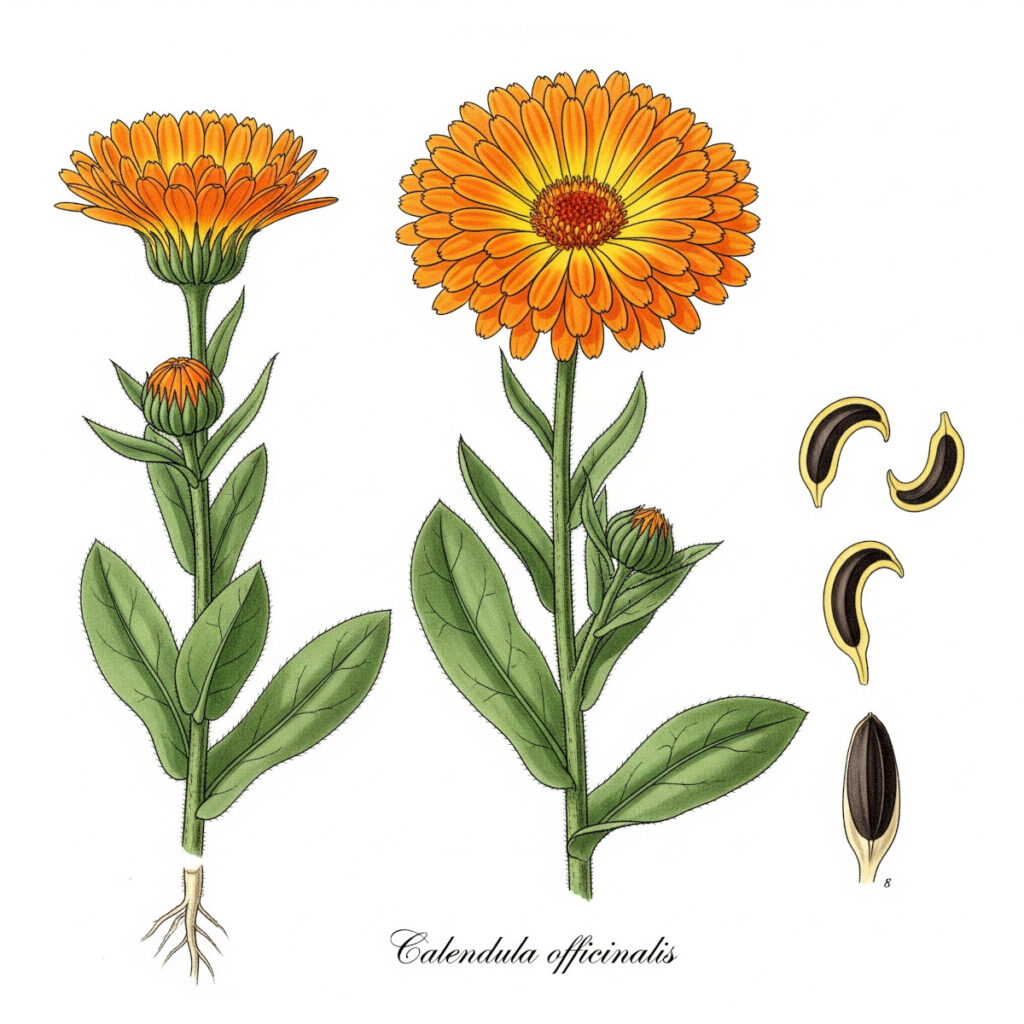
Sources:
Therapeutic Potential of Calendula officinalis
Pharmacological Activities of Calendula Officinalis





